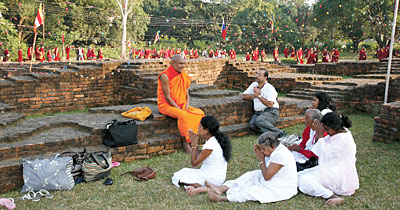 MIN RATNA BAJRACHARYA |
The mystery over the plan by the dubious Asia Pacific Cooperation and Exchange Foundation (APECF) just seems to get shadier by the day.
What began as speculation by a skeptical media has now cast deep doubts about the antecedents of the proposed project, of procedures not followed and what seems to be a deliberate attempt to bypass prevailing laws of the land. Op-eds about the project's attempt to "hijack Lumbini" are appearing thick and fast in the Nepali media.
In June, APECF signed an MoU with the United Nations Industrial Development Organisation (UNIDO) in Beijing to develop Lumbini. But neither the Nepal government nor the UN seem to know anything about it. The agreement was in clear violation of Nepal's domestic laws, and superceded long-standing cooperation with another UN agency, UNESCO, to implement a masterplan for Lumbini.
There is a glaring lack of transparency in the way this project has been conceived and declared. It has tried to bypass the government to push the project through patronage of the influential chairman of the Maoist party and, initially, an ex-crown prince.
To be sure, the project's stated aims and objectives to upgrade tourism infrastructure in Buddha's birthplace could be in the long term interest of the country, particularly because Lumbini has languished as a backwater through the lethargy of successive governments. The project looks to boost government revenue, create jobs, build airports, railways and highways and help reduce poverty. Nowhere in the signed document or the official statement in the website is it stated that the area will be turned into a "Disneyland" or anything of the sort.
A highly placed government official who did not wish to be named told us: "From whatever I have heard and read the project components are in line with the master plan except for the world's tallest Buddha statue proposed inside the 3 sq mile of the heritage site." The functionary feels Nepal could benefit the project, but is put off by the lack of transparency regarding its source of funding and its legitimacy.
The project has even been criticised from within Dahal's own Maoist party where there is a feeling the chairman is trying to "NGO-fy" the party by secretively hobnobbing with questionable organisations. The APECF website introduces Dahal as 'Prachanda, the ex Prime Minister of Nepal' who co-chairs the foundation. It is not yet clear whether he is on its official payroll, but if he is, Dahal may even face personal legal problems for politically promoting a project for personal gain. Paras Shah's involvement in the project remains a speculation, and his name has now vanished from the official website.
The vice chairman of the Lumbini Development Trust (LDT), the chief government body responsible for implementing any activity inside the 3 sq mile area of the Lumbini heritage site, says that the government has not heard officially from the foundation and is not part of the project.
So, we need to make sense why the project has "officially" remained unofficial, if it has indeed been officially signed. Does it have something to do with the fluid political situation in Nepal and the long term benefit to be extracted out of the project? The political and economic brownie points for bringing in a multi-million dollar investment in the country seems to be too tempting for Dahal.
But he risks angering the New Delhi in the process. The Indian Embassy in Kathmandu is known to be taking a dim view of the goings-on and New Delhi has instructed its UN mission in New York to find out what is happening. There is speculation that this is Beijing's way of having a forward-looking strategy to deal with a post-Dalai Lama Tibet. Lumbini could be pushed as an alternative to Indian plans to revive the ancient city of Nalanda as a Buddhist hub, or Bodh Gaya which has served as a meeting point for Tibetan monks.
All this could signal another facet in Sino-Indian geopolitical rivalry, this time for the heart and soul of Buddhism. The question for us is: do we want Lumbini and Nepal to be dragged into a future flashpoint?
Read also:
In the land of the Buddha
Maoist involvement in Chinese-backed plan to develop Lumbini raises suspicion



